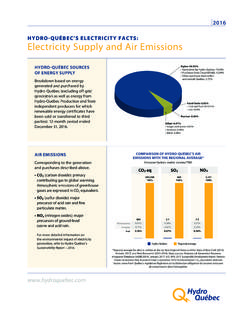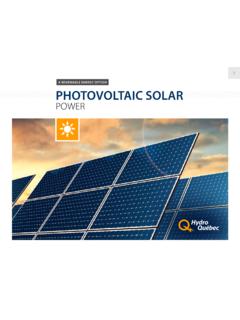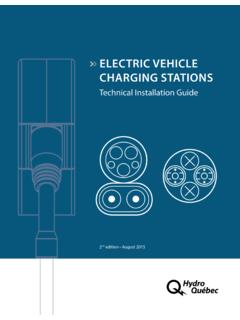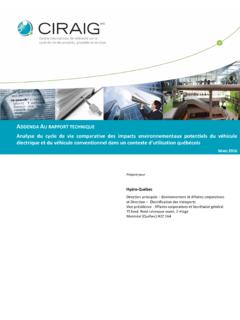Transcription of Renewable energy option. Osmotic power - hydroquebec.com
1 OSMOTICPOWERA Renewable energy OPTION CURRENT STATE OF KNOWLEDGE Osmotic power is in the prototype and demonstration stage. Statkraft, the world leader in the field, tested a prototype os-motic power plant in Norway s Oslo Fjord from 2009 to February 2012 to December 2013, Statkraft and Hydro-Qu bec carried out a joint Osmotic power R&D project. Their primary goal was to develop techniques for pretreating water, assess the impact of water quality on membrane per-formance, and evaluate the process s repercussions for sustain-able development. Osmotic POTENTIAL In Canada, the mouths of large rivers hold considerable long-term potential for Osmotic Qu bec, studies by Hydro-Qu bec s research institute (2011) estimated the exploitable Osmotic potential for the 30 large rivers emptying into saltwater to be 1,860 MW.
2 Fourteen of them (totaling 1,060 MW ) empty into the Golfe du Saint-Laurent (Gulf of St. Lawrence) and its estuary. The challenge today is to generate Osmotic power at a competitive cost by 2020. OUTPUT AND COSTSS tatkraft projects that once the technology has reached matu-rity, gross generating costs will be between 7 and 14 /kWh. Net costs should be based on generating station efficiency esti-mates of 60% to 75%. ADVANTAGES AND DISADVANTAGES [Steady, predictable output [Adaptable for small or large generating stations [Scalable or modular design (membrane modules added as required)]]]
3 , making it possible to increase installed capacity [ generating sites near load centres, limiting power trans-mission needs [Good potential for power plant sites [Technology similar and complementary to that of hydro-electric power , with Osmotic power plants able to be built on already-harnessed rivers [High risk of clogging and gradual degradation of semi-permeable membranes, necessitating pressure-filtering pretreatment of fresh water and periodic membrane re-placement (every 5 to 7 years) Osmotic power : THE energy DERIVED FROM THE DIFFERENCE IN SALINITY BETWEEN SEAWATER AND FRESH WATER, CONVERTED INTO ELECTRICITY BY MEANS OF A TURBINEC over: Statkraft s prototype Osmotic power plant in Norway StatkraftTHE energy OF WATERA Renewable energy OPTIONOSMOTIC POWER2 SUSTAINABLE DEVELOPMENT At this time, little is known about the social and environmental impacts of Osmotic generating station operations and mainte-nance.]]]]
4 To some degree, they are similar to those of water pu-rification plants that use membrane filtration, which are well documented: [Modification of habitat and vegetation, with potential re-percussions on aquatic fauna (among other things, changes in salinity and regular large-volume discharges of brackish water may affect the natural mix of river water and seawater) [Potential effects of the use of cleaning products [Production of wet waste (sludge and used membranes) [Impact on the host environment to be expected if a dike or basin has to be built to optimize a site s potential [Possible conflicts with shipping, fishing, etc.]]]]]
5 [Zero greenhouse gas and atmospheric contaminant emis-sions during operationLEARN MORE How an Osmotic generating station works Canada s Osmotic potential The Statkraft prototype Research around the world Climate change and air quality Life cycle assessment Ecosystems and biodiversity Health and quality of life Land use Regional economy Social acceptability+A Renewable energy OPTIONOSMOTIC POWER3 How an Osmotic generating station worksWhen fresh water is separated from seawater by a semiperme-able membrane, the fresh water moves by osmosis through the membrane into the seawater, raising the pressure on the seawater side.]
6 This is referred to as Osmotic pressure and is used to drive a pressure is the cornerstone of the energy - generating method conceived by American Sydney Loeb in the 1970s but developed and put into practice by Norway s Statkraft Group between 1997 and Osmotic generating station has a limited number of components: [A semipermeable membrane contained in modules [Freshwater and seawater filters that optimize membrane performance [A turbine that generates a driving force based on the Osmotic pressure and permeation flow rate [A pressure exchanger that pressurizes the seawater feed required to maintain high salinity levels downstream from the membraneConcentrate dischargeMembraneTurbineBrackish waterFresh waterSalt waterPressure exchangerPretreatmentPretreatmentELECTRI CITY GENERATIONA SUSTAINABLE RESSOURCEA Renewable energy OPTIONOSMOTIC POWER4 The Statkraft prototypeHurum]]]]
7 Osmotic generating station in the Oslo fjord, NorwayStatkraft installed its 4-kW prototype Osmotic generating station in the Tofte paper mill in Hurum, Norway. The station used sea-water from the fjord and fresh water from a nearby river circulat-ing in two chambers separated by a semipermeable membrane. This type of technology is referred to as pressure-retarded osmo-sis, or around the worldSince 2007, Deltares, the Dutch research centre on applied water, soil and subsurface technologies, has worked with busi-nesses and other research centres to advance understanding of Osmotic power .
8 As part of the Netherlands government s ongoing Blue energy demonstration project, efforts are being made to demonstrate the electricity- generating potential of pressure-retarded osmosis. In November 2014, a 50-kW gener-ating station was commissioned in the , a centre of excellence for sustainable water tech-nology, designs and develops reverse electrodialysis (RED) technology, also as part of the Blue energy program. It works in partnership with KEMA and conjunction with Yale University, the University of Connecticut has developed a closed-cycle Osmotic heat engine that uses a H O-NH -CO solution.
9 First used to desalinate water by harnessing waste heat, this process, called Engineered Osmosis , has been adapted to generate power . It has been commercialized by Oasys s Osmotic potentialSITES WITH Osmotic POTENTIALB ritish Columbia 580 MWManitoba 340 MWOntario 250 MWQu bec 1,860 MWNewfoundland and Labrador 320 MWNorthwest Territories 620 MWNunavut 230 MW Site with Osmotic potential Source: Institut de recherche d Hydro-Qu becNB: Osmotic potential (MW) is calculated as 15% of the average flow of the indexed Renewable energy OPTIONOSMOTIC POWER5In 2009, the Tokyo Institute of Technology commissioned a prototype PRO generating station near the Uminonakamichi Nata Sea Water Desalination Center in Fukuoka, Japan.
10 The goal was to extract energy from salinity gradients at the interface between concentrate from a seawater desalination plant and fresh water released from a waste water treatment plant. The prototype was part of the Mega-ton Water System project, which involved designing a seawater desalination plant with a capacity of one million cubic metres a day and was carried out between 2010 and change and air qualityIn Osmotic power , greenhouse gas and air contaminant emis-sions are produced solely during infrastructure manufacturing and installation. During the operations phase, Osmotic gener-ating stations do not produce any cycle assessmentAt this time, there are no available studies on the Osmotic gen-erating station life cycle.














